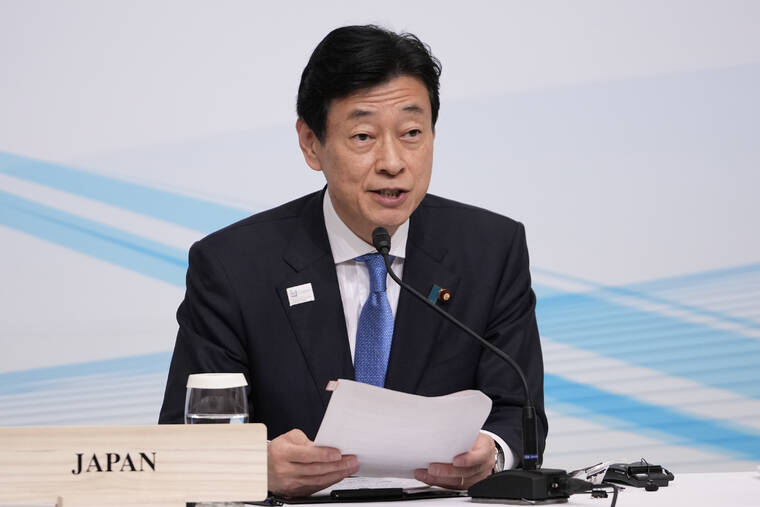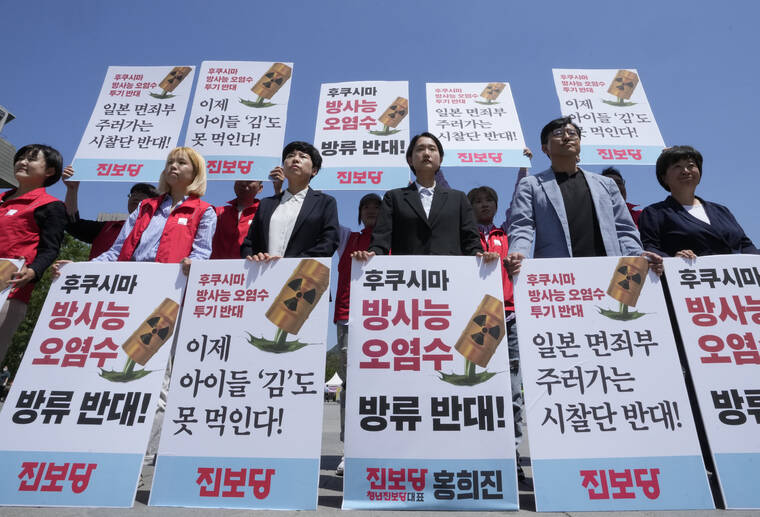Fukushima nuclear plant plans to release treated water into sea

ASSOCIATED PRESS / APRIL 16
Japan’s Economy Minister Yasutoshi Nishimura speaks during a joint news conference by host country Japan, Germany and Italy in the G7 ministers’ meeting on climate, energy and environment in Sapporo, northern Japan. A South Korean team of government experts has begun a two-day tour at the tsunami-wrecked Fukushima nuclear power plant on Tuesday, May 23, to have a first-hand look of a controversial Japanese plan to release into sea treated by slightly radioactive wastewater. “We plan to provide thorough explanation to the South Korean experts as we show them the latest status of the tanks and construction at the plant,” said Nishimura.

ASSOCIATED PRESS
Members of the minor progressive Jinbo Party stage a rally against Japanese government’s decision to release treated radioactive water from Fukushima nuclear power plant, in Seoul, South Korea. South Korea sent a team of government experts to Japan on Sunday, May 21, to visit the Fukushima nuclear power plant where they will review contentious Japanese plans to release treated but slightly radioactive water into the sea. The signs read “Oppose to release treated radioactive water from the Fukushima.”


TOKYO >> A team of South Korean government experts began a two-day tour of Japan’s tsunami-wrecked Fukushima nuclear power plant on Tuesday to examine a contentious plan to release treated but still slightly radioactive wastewater into the sea.
Officials from the Japanese government and the plant operator, Tokyo Electric Power Company Holdings, were to show the 21-member delegation several facilities related to treatment, safety checks, transport and dilution of the water, Japanese officials said Tuesday.
The plan has faced fierce protests from local fishing communities concerned about safety and reputational damage. Neighboring countries, including South Korea, China and Pacific Island nations, have also raised safety concerns.
The water discharge plan has particularly been a sensitive issue between Tokyo and Seoul, which are now working to repair long-strained bilateral ties to address bigger challenges such as security threats from China and North Korea.
Yoo Guk-hee, the chairperson of South Korea’s Nuclear Safety and Security Commission who heads the delegation, told reporters after the first day’s visit that his team needs more data, including about the water filtering system, to determine contamination levels before and after treatment and whether it is safely operated. “We will need all the information to reach an overall conclusion,” he said.
“What we are trying to focus on is to determine, based on scientific evidence and standards, how these facilities work and whether these facilities are working properly, as well as whether the discharge procedure and process are adequate,” Yoo said. Asked if there is anything that can be done to quell South Korean people’s anxiety over the discharge plan, he said, “If we can explain in detail what we have inspected, I think that is meaningful.”
Don't miss out on what's happening!
Stay in touch with breaking news, as it happens, conveniently in your email inbox. It's FREE!
Japanese Trade and Industry Minister Yasutoshi Nishimura promised earlier Tuesday to provide a “thorough explanation” to the South Korean experts and show them the current status of water tanks, other facilities and construction at the plant. “I expect this will deepen the understanding in South Korea about the safety of our planned release” of the treated water, Nishimura said.
He has said the South Korean team’s visit is not an inspection of the discharge plan, which is already under review by the International Atomic Energy Agency, a U.N. nuclear watchdog. After its second day at the plant Wednesday, Yoo’s team is to meet with Japanese officials in Tokyo before heading home Friday.
Japanese officials say only water that has been treated to legally releasable levels and further diluted with large amounts of seawater will be released into the sea about 1 kilometer (0.6 mile) offshore through an undersea tunnel, and the controlled release over decades will make it harmless to people and marine life.
Some scientists say the impact of long-term, low-dose exposure to tritium and other radionuclides is unknown and the release should be delayed.
Historical disputes have strained ties between Tokyo and Seoul — most recently over the compensation of Koreans who were forced laborers during Japan’s 1910-1945 colonization of the Korean Peninsula. But their relationship has thawed rapidly since March, when South Korea’s government announced a local fund would compensate some of the former laborers. Tokyo and Seoul, under pressure from Washington, share a sense of urgency to mend ties amid growing security threats in the region.
Nishimura said the government and TEPCO plan to start releasing the treated water after compulsory safety checks by Japanese nuclear regulators and a final review report by the IAEA.
A massive earthquake and tsunami on March 11, 2011, destroyed the Fukushima Daiichi plant’s cooling systems, causing three reactors to melt, releasing large amounts of radiation. Water used to cool the reactor cores has accumulated in about 1,000 tanks at the plant, which will reach their capacity in early 2024.
Japanese officials say the water stored in the tanks needs to be removed to prevent accidental leaks in case of another disaster and to make room for the plant’s decommissioning.
AP video journalist Yong Jun Chang in Seoul, South Korea, contributed to this report.



